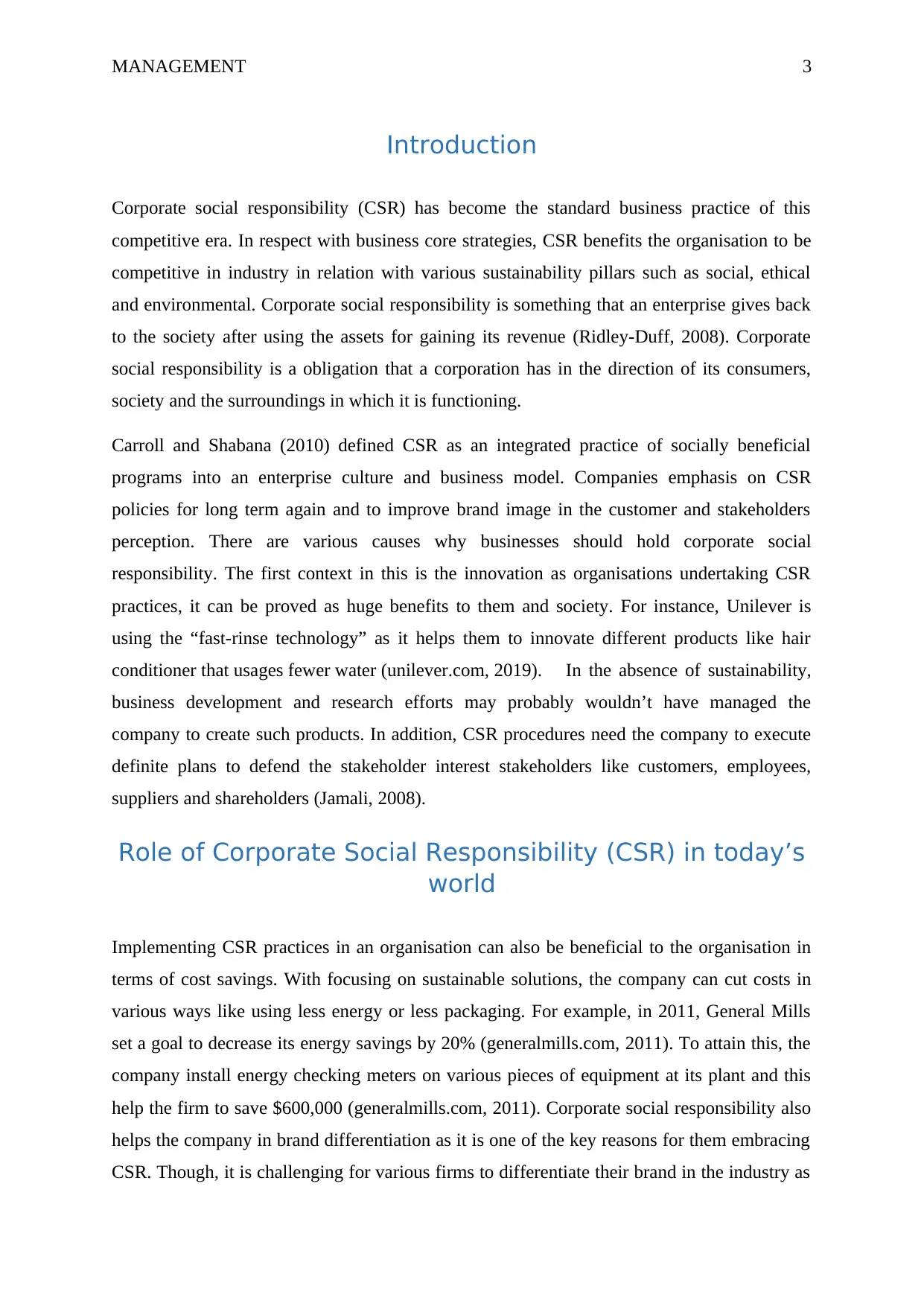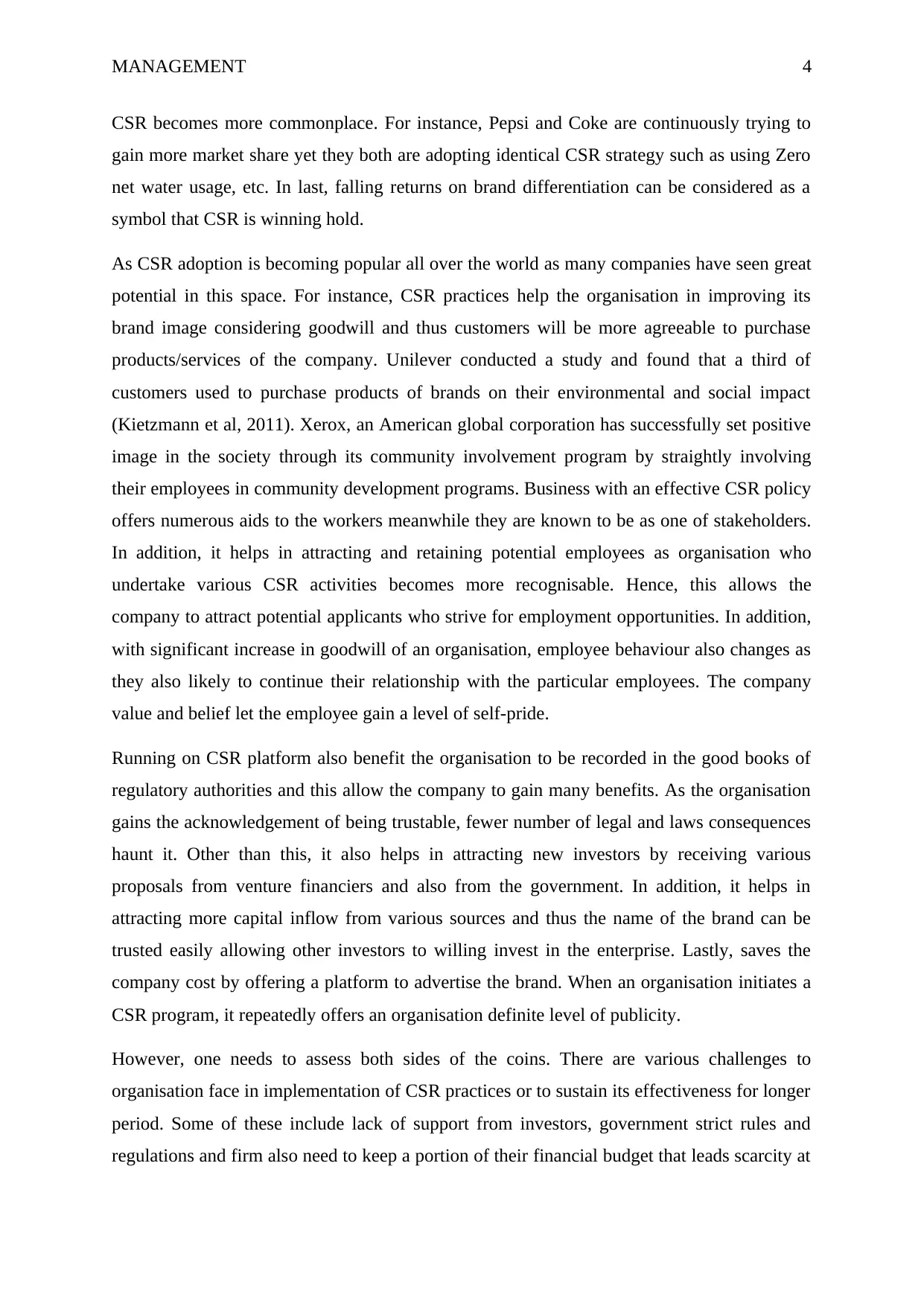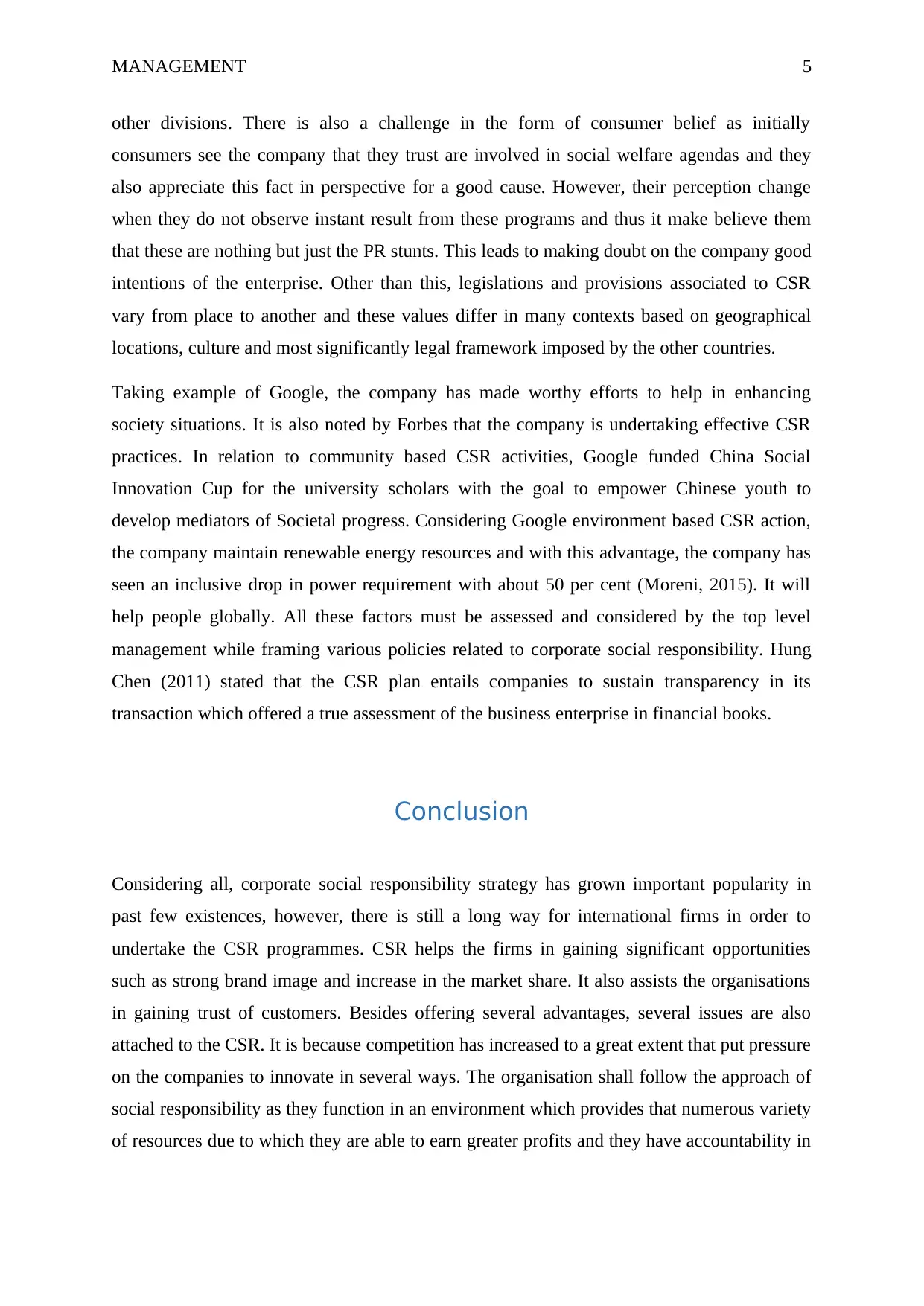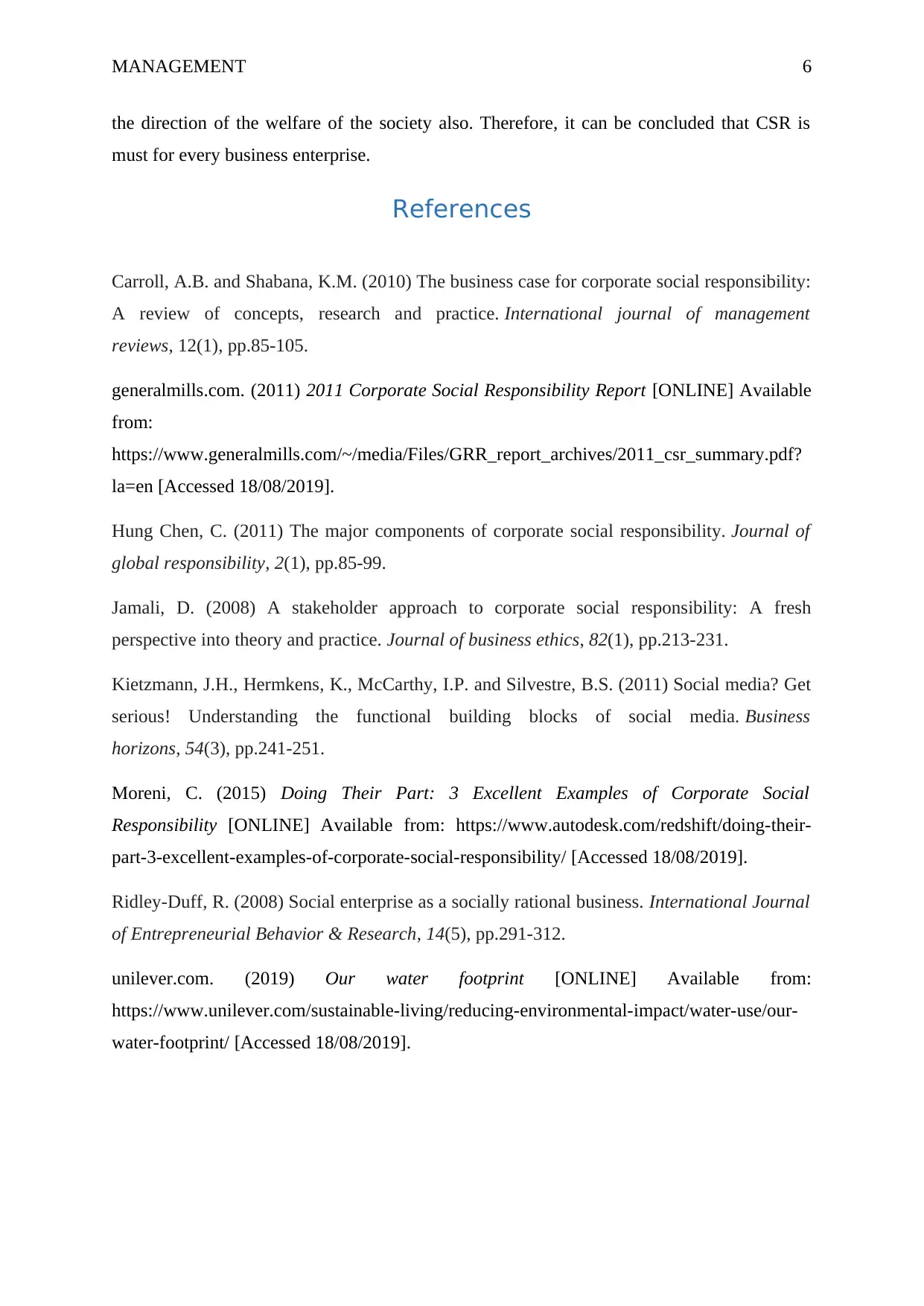Managing Across Borders: Corporate Social Responsibility Report
VerifiedAdded on 2022/09/21
|7
|1717
|14
Report
AI Summary
This report provides an overview of Corporate Social Responsibility (CSR), defining it as a crucial business practice that promotes a constructive impact on employees, customers, the environment, and other stakeholders. The report highlights the benefits of CSR, including innovation, cost savings, brand differentiation, and improved brand image, using examples from companies like Unilever and General Mills. It also examines the role of CSR in attracting and retaining employees, gaining regulatory acceptance, and attracting investors. Furthermore, the report addresses the challenges associated with CSR implementation, such as lack of investor support, consumer skepticism, and varying regulations. The analysis includes case studies of Google and Xerox to illustrate effective CSR practices. In conclusion, the report emphasizes the growing importance of CSR for businesses seeking to enhance their brand image, market share, and stakeholder trust, while acknowledging the need for transparency and adaptability in CSR strategies.

Running Head: MANAGEMENT 0
Managing Across Borders
Managing Across Borders
Paraphrase This Document
Need a fresh take? Get an instant paraphrase of this document with our AI Paraphraser

MANAGEMENT 1
Executive Summary
This report outlines about importance and role of Corporate Social Responsibility in present
world. Corporate social responsibility (CSR) can be defined as accepting responsibility and
promoting a constructive impact through the business’s practices associated to the employees,
customers, environment, society and other stakeholders. Various examples are also being
undertaken to learn the concept and CSR from various perspectives.
Executive Summary
This report outlines about importance and role of Corporate Social Responsibility in present
world. Corporate social responsibility (CSR) can be defined as accepting responsibility and
promoting a constructive impact through the business’s practices associated to the employees,
customers, environment, society and other stakeholders. Various examples are also being
undertaken to learn the concept and CSR from various perspectives.

MANAGEMENT 2
Table of Contents
Introduction................................................................................................................................3
Role of Corporate Social Responsibility (CSR) in today’s world.............................................3
Conclusion..................................................................................................................................5
References..................................................................................................................................6
Table of Contents
Introduction................................................................................................................................3
Role of Corporate Social Responsibility (CSR) in today’s world.............................................3
Conclusion..................................................................................................................................5
References..................................................................................................................................6
⊘ This is a preview!⊘
Do you want full access?
Subscribe today to unlock all pages.

Trusted by 1+ million students worldwide

MANAGEMENT 3
Introduction
Corporate social responsibility (CSR) has become the standard business practice of this
competitive era. In respect with business core strategies, CSR benefits the organisation to be
competitive in industry in relation with various sustainability pillars such as social, ethical
and environmental. Corporate social responsibility is something that an enterprise gives back
to the society after using the assets for gaining its revenue (Ridley-Duff, 2008). Corporate
social responsibility is a obligation that a corporation has in the direction of its consumers,
society and the surroundings in which it is functioning.
Carroll and Shabana (2010) defined CSR as an integrated practice of socially beneficial
programs into an enterprise culture and business model. Companies emphasis on CSR
policies for long term again and to improve brand image in the customer and stakeholders
perception. There are various causes why businesses should hold corporate social
responsibility. The first context in this is the innovation as organisations undertaking CSR
practices, it can be proved as huge benefits to them and society. For instance, Unilever is
using the “fast-rinse technology” as it helps them to innovate different products like hair
conditioner that usages fewer water (unilever.com, 2019). In the absence of sustainability,
business development and research efforts may probably wouldn’t have managed the
company to create such products. In addition, CSR procedures need the company to execute
definite plans to defend the stakeholder interest stakeholders like customers, employees,
suppliers and shareholders (Jamali, 2008).
Role of Corporate Social Responsibility (CSR) in today’s
world
Implementing CSR practices in an organisation can also be beneficial to the organisation in
terms of cost savings. With focusing on sustainable solutions, the company can cut costs in
various ways like using less energy or less packaging. For example, in 2011, General Mills
set a goal to decrease its energy savings by 20% (generalmills.com, 2011). To attain this, the
company install energy checking meters on various pieces of equipment at its plant and this
help the firm to save $600,000 (generalmills.com, 2011). Corporate social responsibility also
helps the company in brand differentiation as it is one of the key reasons for them embracing
CSR. Though, it is challenging for various firms to differentiate their brand in the industry as
Introduction
Corporate social responsibility (CSR) has become the standard business practice of this
competitive era. In respect with business core strategies, CSR benefits the organisation to be
competitive in industry in relation with various sustainability pillars such as social, ethical
and environmental. Corporate social responsibility is something that an enterprise gives back
to the society after using the assets for gaining its revenue (Ridley-Duff, 2008). Corporate
social responsibility is a obligation that a corporation has in the direction of its consumers,
society and the surroundings in which it is functioning.
Carroll and Shabana (2010) defined CSR as an integrated practice of socially beneficial
programs into an enterprise culture and business model. Companies emphasis on CSR
policies for long term again and to improve brand image in the customer and stakeholders
perception. There are various causes why businesses should hold corporate social
responsibility. The first context in this is the innovation as organisations undertaking CSR
practices, it can be proved as huge benefits to them and society. For instance, Unilever is
using the “fast-rinse technology” as it helps them to innovate different products like hair
conditioner that usages fewer water (unilever.com, 2019). In the absence of sustainability,
business development and research efforts may probably wouldn’t have managed the
company to create such products. In addition, CSR procedures need the company to execute
definite plans to defend the stakeholder interest stakeholders like customers, employees,
suppliers and shareholders (Jamali, 2008).
Role of Corporate Social Responsibility (CSR) in today’s
world
Implementing CSR practices in an organisation can also be beneficial to the organisation in
terms of cost savings. With focusing on sustainable solutions, the company can cut costs in
various ways like using less energy or less packaging. For example, in 2011, General Mills
set a goal to decrease its energy savings by 20% (generalmills.com, 2011). To attain this, the
company install energy checking meters on various pieces of equipment at its plant and this
help the firm to save $600,000 (generalmills.com, 2011). Corporate social responsibility also
helps the company in brand differentiation as it is one of the key reasons for them embracing
CSR. Though, it is challenging for various firms to differentiate their brand in the industry as
Paraphrase This Document
Need a fresh take? Get an instant paraphrase of this document with our AI Paraphraser

MANAGEMENT 4
CSR becomes more commonplace. For instance, Pepsi and Coke are continuously trying to
gain more market share yet they both are adopting identical CSR strategy such as using Zero
net water usage, etc. In last, falling returns on brand differentiation can be considered as a
symbol that CSR is winning hold.
As CSR adoption is becoming popular all over the world as many companies have seen great
potential in this space. For instance, CSR practices help the organisation in improving its
brand image considering goodwill and thus customers will be more agreeable to purchase
products/services of the company. Unilever conducted a study and found that a third of
customers used to purchase products of brands on their environmental and social impact
(Kietzmann et al, 2011). Xerox, an American global corporation has successfully set positive
image in the society through its community involvement program by straightly involving
their employees in community development programs. Business with an effective CSR policy
offers numerous aids to the workers meanwhile they are known to be as one of stakeholders.
In addition, it helps in attracting and retaining potential employees as organisation who
undertake various CSR activities becomes more recognisable. Hence, this allows the
company to attract potential applicants who strive for employment opportunities. In addition,
with significant increase in goodwill of an organisation, employee behaviour also changes as
they also likely to continue their relationship with the particular employees. The company
value and belief let the employee gain a level of self-pride.
Running on CSR platform also benefit the organisation to be recorded in the good books of
regulatory authorities and this allow the company to gain many benefits. As the organisation
gains the acknowledgement of being trustable, fewer number of legal and laws consequences
haunt it. Other than this, it also helps in attracting new investors by receiving various
proposals from venture financiers and also from the government. In addition, it helps in
attracting more capital inflow from various sources and thus the name of the brand can be
trusted easily allowing other investors to willing invest in the enterprise. Lastly, saves the
company cost by offering a platform to advertise the brand. When an organisation initiates a
CSR program, it repeatedly offers an organisation definite level of publicity.
However, one needs to assess both sides of the coins. There are various challenges to
organisation face in implementation of CSR practices or to sustain its effectiveness for longer
period. Some of these include lack of support from investors, government strict rules and
regulations and firm also need to keep a portion of their financial budget that leads scarcity at
CSR becomes more commonplace. For instance, Pepsi and Coke are continuously trying to
gain more market share yet they both are adopting identical CSR strategy such as using Zero
net water usage, etc. In last, falling returns on brand differentiation can be considered as a
symbol that CSR is winning hold.
As CSR adoption is becoming popular all over the world as many companies have seen great
potential in this space. For instance, CSR practices help the organisation in improving its
brand image considering goodwill and thus customers will be more agreeable to purchase
products/services of the company. Unilever conducted a study and found that a third of
customers used to purchase products of brands on their environmental and social impact
(Kietzmann et al, 2011). Xerox, an American global corporation has successfully set positive
image in the society through its community involvement program by straightly involving
their employees in community development programs. Business with an effective CSR policy
offers numerous aids to the workers meanwhile they are known to be as one of stakeholders.
In addition, it helps in attracting and retaining potential employees as organisation who
undertake various CSR activities becomes more recognisable. Hence, this allows the
company to attract potential applicants who strive for employment opportunities. In addition,
with significant increase in goodwill of an organisation, employee behaviour also changes as
they also likely to continue their relationship with the particular employees. The company
value and belief let the employee gain a level of self-pride.
Running on CSR platform also benefit the organisation to be recorded in the good books of
regulatory authorities and this allow the company to gain many benefits. As the organisation
gains the acknowledgement of being trustable, fewer number of legal and laws consequences
haunt it. Other than this, it also helps in attracting new investors by receiving various
proposals from venture financiers and also from the government. In addition, it helps in
attracting more capital inflow from various sources and thus the name of the brand can be
trusted easily allowing other investors to willing invest in the enterprise. Lastly, saves the
company cost by offering a platform to advertise the brand. When an organisation initiates a
CSR program, it repeatedly offers an organisation definite level of publicity.
However, one needs to assess both sides of the coins. There are various challenges to
organisation face in implementation of CSR practices or to sustain its effectiveness for longer
period. Some of these include lack of support from investors, government strict rules and
regulations and firm also need to keep a portion of their financial budget that leads scarcity at

MANAGEMENT 5
other divisions. There is also a challenge in the form of consumer belief as initially
consumers see the company that they trust are involved in social welfare agendas and they
also appreciate this fact in perspective for a good cause. However, their perception change
when they do not observe instant result from these programs and thus it make believe them
that these are nothing but just the PR stunts. This leads to making doubt on the company good
intentions of the enterprise. Other than this, legislations and provisions associated to CSR
vary from place to another and these values differ in many contexts based on geographical
locations, culture and most significantly legal framework imposed by the other countries.
Taking example of Google, the company has made worthy efforts to help in enhancing
society situations. It is also noted by Forbes that the company is undertaking effective CSR
practices. In relation to community based CSR activities, Google funded China Social
Innovation Cup for the university scholars with the goal to empower Chinese youth to
develop mediators of Societal progress. Considering Google environment based CSR action,
the company maintain renewable energy resources and with this advantage, the company has
seen an inclusive drop in power requirement with about 50 per cent (Moreni, 2015). It will
help people globally. All these factors must be assessed and considered by the top level
management while framing various policies related to corporate social responsibility. Hung
Chen (2011) stated that the CSR plan entails companies to sustain transparency in its
transaction which offered a true assessment of the business enterprise in financial books.
Conclusion
Considering all, corporate social responsibility strategy has grown important popularity in
past few existences, however, there is still a long way for international firms in order to
undertake the CSR programmes. CSR helps the firms in gaining significant opportunities
such as strong brand image and increase in the market share. It also assists the organisations
in gaining trust of customers. Besides offering several advantages, several issues are also
attached to the CSR. It is because competition has increased to a great extent that put pressure
on the companies to innovate in several ways. The organisation shall follow the approach of
social responsibility as they function in an environment which provides that numerous variety
of resources due to which they are able to earn greater profits and they have accountability in
other divisions. There is also a challenge in the form of consumer belief as initially
consumers see the company that they trust are involved in social welfare agendas and they
also appreciate this fact in perspective for a good cause. However, their perception change
when they do not observe instant result from these programs and thus it make believe them
that these are nothing but just the PR stunts. This leads to making doubt on the company good
intentions of the enterprise. Other than this, legislations and provisions associated to CSR
vary from place to another and these values differ in many contexts based on geographical
locations, culture and most significantly legal framework imposed by the other countries.
Taking example of Google, the company has made worthy efforts to help in enhancing
society situations. It is also noted by Forbes that the company is undertaking effective CSR
practices. In relation to community based CSR activities, Google funded China Social
Innovation Cup for the university scholars with the goal to empower Chinese youth to
develop mediators of Societal progress. Considering Google environment based CSR action,
the company maintain renewable energy resources and with this advantage, the company has
seen an inclusive drop in power requirement with about 50 per cent (Moreni, 2015). It will
help people globally. All these factors must be assessed and considered by the top level
management while framing various policies related to corporate social responsibility. Hung
Chen (2011) stated that the CSR plan entails companies to sustain transparency in its
transaction which offered a true assessment of the business enterprise in financial books.
Conclusion
Considering all, corporate social responsibility strategy has grown important popularity in
past few existences, however, there is still a long way for international firms in order to
undertake the CSR programmes. CSR helps the firms in gaining significant opportunities
such as strong brand image and increase in the market share. It also assists the organisations
in gaining trust of customers. Besides offering several advantages, several issues are also
attached to the CSR. It is because competition has increased to a great extent that put pressure
on the companies to innovate in several ways. The organisation shall follow the approach of
social responsibility as they function in an environment which provides that numerous variety
of resources due to which they are able to earn greater profits and they have accountability in
⊘ This is a preview!⊘
Do you want full access?
Subscribe today to unlock all pages.

Trusted by 1+ million students worldwide

MANAGEMENT 6
the direction of the welfare of the society also. Therefore, it can be concluded that CSR is
must for every business enterprise.
References
Carroll, A.B. and Shabana, K.M. (2010) The business case for corporate social responsibility:
A review of concepts, research and practice. International journal of management
reviews, 12(1), pp.85-105.
generalmills.com. (2011) 2011 Corporate Social Responsibility Report [ONLINE] Available
from:
https://www.generalmills.com/~/media/Files/GRR_report_archives/2011_csr_summary.pdf?
la=en [Accessed 18/08/2019].
Hung Chen, C. (2011) The major components of corporate social responsibility. Journal of
global responsibility, 2(1), pp.85-99.
Jamali, D. (2008) A stakeholder approach to corporate social responsibility: A fresh
perspective into theory and practice. Journal of business ethics, 82(1), pp.213-231.
Kietzmann, J.H., Hermkens, K., McCarthy, I.P. and Silvestre, B.S. (2011) Social media? Get
serious! Understanding the functional building blocks of social media. Business
horizons, 54(3), pp.241-251.
Moreni, C. (2015) Doing Their Part: 3 Excellent Examples of Corporate Social
Responsibility [ONLINE] Available from: https://www.autodesk.com/redshift/doing-their-
part-3-excellent-examples-of-corporate-social-responsibility/ [Accessed 18/08/2019].
Ridley-Duff, R. (2008) Social enterprise as a socially rational business. International Journal
of Entrepreneurial Behavior & Research, 14(5), pp.291-312.
unilever.com. (2019) Our water footprint [ONLINE] Available from:
https://www.unilever.com/sustainable-living/reducing-environmental-impact/water-use/our-
water-footprint/ [Accessed 18/08/2019].
the direction of the welfare of the society also. Therefore, it can be concluded that CSR is
must for every business enterprise.
References
Carroll, A.B. and Shabana, K.M. (2010) The business case for corporate social responsibility:
A review of concepts, research and practice. International journal of management
reviews, 12(1), pp.85-105.
generalmills.com. (2011) 2011 Corporate Social Responsibility Report [ONLINE] Available
from:
https://www.generalmills.com/~/media/Files/GRR_report_archives/2011_csr_summary.pdf?
la=en [Accessed 18/08/2019].
Hung Chen, C. (2011) The major components of corporate social responsibility. Journal of
global responsibility, 2(1), pp.85-99.
Jamali, D. (2008) A stakeholder approach to corporate social responsibility: A fresh
perspective into theory and practice. Journal of business ethics, 82(1), pp.213-231.
Kietzmann, J.H., Hermkens, K., McCarthy, I.P. and Silvestre, B.S. (2011) Social media? Get
serious! Understanding the functional building blocks of social media. Business
horizons, 54(3), pp.241-251.
Moreni, C. (2015) Doing Their Part: 3 Excellent Examples of Corporate Social
Responsibility [ONLINE] Available from: https://www.autodesk.com/redshift/doing-their-
part-3-excellent-examples-of-corporate-social-responsibility/ [Accessed 18/08/2019].
Ridley-Duff, R. (2008) Social enterprise as a socially rational business. International Journal
of Entrepreneurial Behavior & Research, 14(5), pp.291-312.
unilever.com. (2019) Our water footprint [ONLINE] Available from:
https://www.unilever.com/sustainable-living/reducing-environmental-impact/water-use/our-
water-footprint/ [Accessed 18/08/2019].
1 out of 7
Related Documents
Your All-in-One AI-Powered Toolkit for Academic Success.
+13062052269
info@desklib.com
Available 24*7 on WhatsApp / Email
![[object Object]](/_next/static/media/star-bottom.7253800d.svg)
Unlock your academic potential
Copyright © 2020–2025 A2Z Services. All Rights Reserved. Developed and managed by ZUCOL.





